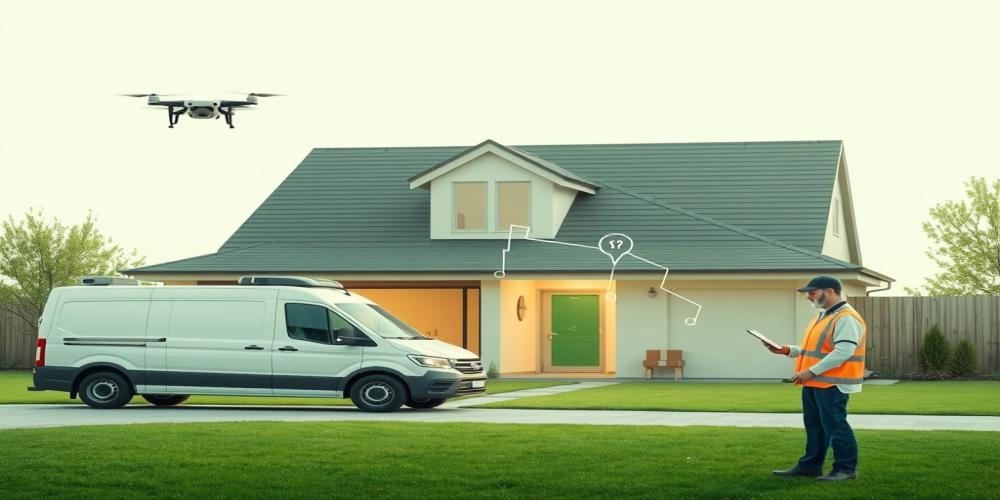AI Innovations in Logistics and Delivery for Home Services
Introduction
AI-driven technologies are reshaping logistics and delivery for home services — from plumbing and HVAC to grocery and medical deliveries. By applying machine learning, computer vision, robotics, and advanced optimization, companies can reduce costs, speed up response times, and deliver more reliable, personalized customer experiences for in-home and last-mile services.
Core AI Technologies Transforming Home Services
Route Optimization and Dynamic Scheduling
Advanced algorithms analyze real-time traffic, service durations, technician skills, and customer preferences to generate optimal routes and schedules. AI continuously re-optimizes in response to delays, cancellations, or new urgent requests to maximize technician utilization and minimize travel time.
Demand Forecasting and Capacity Planning
Machine learning models predict demand patterns by neighborhood, time of day, seasonality, and service type. This enables companies to staff appropriately, stage inventory near high-demand zones, and pre-position mobile workshops or supply hubs for faster response.
Autonomous Vehicles, Drones, and Robots
Autonomous vans and delivery robots handle routine last-mile transport, while drones speed delivery of small parts and medical supplies to hard-to-reach locations. These systems reduce labor costs and shorten delivery windows for high-frequency, low-weight items used by home service technicians.
Computer Vision and On-site Assistance
Technicians use AI-powered image recognition for diagnostics and parts identification. Customers share photos or livestreams that AI analyzes to pre-diagnose issues, enabling field teams to arrive with correct parts and instructions, reducing repeat visits.
Predictive Maintenance and Fleet Management
AI monitors vehicle telematics and service tools to predict failures before they occur, improving fleet uptime and safety. Predictive maintenance reduces unexpected downtime and ensures technicians have dependable transport and functioning equipment.
Intelligent Dispatch and Workforce Matching
AI platforms match job requirements with technician skills, certifications, location, and current workload. This improves first-time fix rates, customer satisfaction, and fair distribution of work across the field team.
Use Cases in Home Services
Emergency Repair Response
For urgent issues (e.g., gas leaks, water damage), AI accelerates dispatch by prioritizing based on severity, proximity, and technician qualifications. Real-time routing and ETA updates keep customers informed and reduce risk exposure.
Scheduled Maintenance and Preventive Visits
Predictive models trigger proactive home visits for HVAC or appliance servicing based on usage patterns and historical failures. Customers benefit from fewer breakdowns and lower overall maintenance costs.
Parts-on-Demand and Mobile Inventory
AI predicts which parts are likely needed for upcoming appointments and recommends stocking decisions for mobile vans. This reduces return trips and boosts first-visit repair rates.
Contactless and Autonomous Delivery for Consumables
Robots and drones can deliver replacement filters, consumables, or small tools directly to customers between technician visits, providing convenience and reducing wait times.
Benefits for Businesses and Customers
Improved Efficiency and Cost Savings
Reduced travel times, fewer repeat visits, and better fleet utilization lower operational costs. AI-driven scheduling and routing enable companies to serve more customers with the same workforce.
Enhanced Customer Experience
Accurate ETAs, proactive notifications, fast resolution, and tailored service recommendations increase trust and satisfaction. Visual diagnostics and virtual assistance add transparency and speed.
Higher First-Time Fix Rates
Better matching of skills, accurate parts prediction, and real-time diagnostic data increase the likelihood that technicians resolve issues in a single visit, improving productivity and customer loyalty.
Challenges and Considerations
Data Quality and Integration
AI models require high-quality, integrated data from CRM, telematics, inventory, and IoT devices. Data silos and inconsistent records reduce model effectiveness and must be addressed early in implementation.
Regulation and Safety
Autonomous vehicles and drones face regulatory hurdles and safety considerations. Compliance with local laws, airspace rules, and privacy regulations is essential before large-scale deployment.
Trust and Human Acceptance
Customers and field personnel may be wary of autonomous systems and AI decision-making. Clear communication, transparent policies, and gradual introduction of automation help build acceptance.
Cybersecurity and Privacy
Home-service AI systems handle sensitive customer data and control physical assets. Robust security practices, encryption, and secure access controls are required to mitigate risks.
Implementation Roadmap
Start with High-Impact, Low-Risk Use Cases
Pilot route optimization, dynamic dispatch, or predictive parts stocking before moving to autonomous vehicles. Early wins build momentum and ROI proof points.
Invest in Data Foundations
Clean, unified data pipelines and consistent tagging of service events, parts, and customer interactions are prerequisites for reliable AI models.
Combine Human Expertise with AI
Design systems that augment technicians—suggesting parts, highlighting diagnostics, and offering next-best actions—rather than replacing experienced field staff.
Scale Gradually and Measure Outcomes
Track KPIs such as travel time reduction, first-time fix rate, customer satisfaction, and cost per job. Use these metrics to guide incremental scaling and additional AI features.
Future Outlook
AI will further blur the line between physical and digital service delivery. Expect richer smart-home integration, preemptive supply chains that anticipate failures, and hybrid human-robot teams handling complex in-home tasks. Advances in edge computing, 5G connectivity, and federated learning will enable faster, privacy-preserving models operating closer to the home.
Conclusion
AI innovations in logistics and delivery hold significant promise for home services: faster response, lower costs, improved first-visit resolution, and better customer experiences. Realizing these benefits requires careful attention to data, regulatory compliance, workforce enablement, and secure system design. Organizations that combine thoughtful AI adoption with human-centric service models will lead the next wave of home-service excellence.










